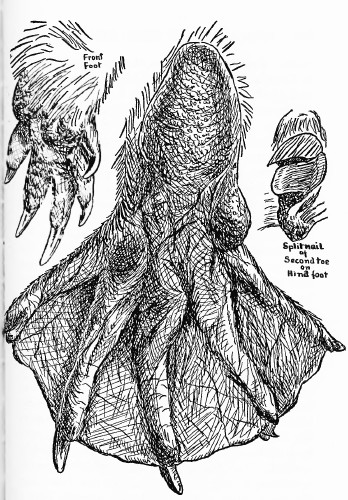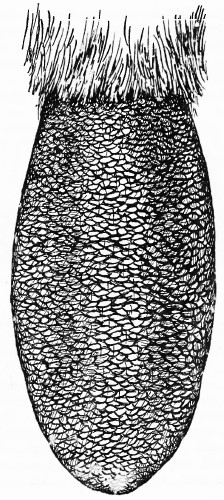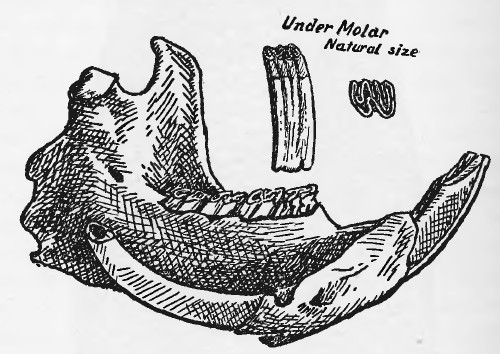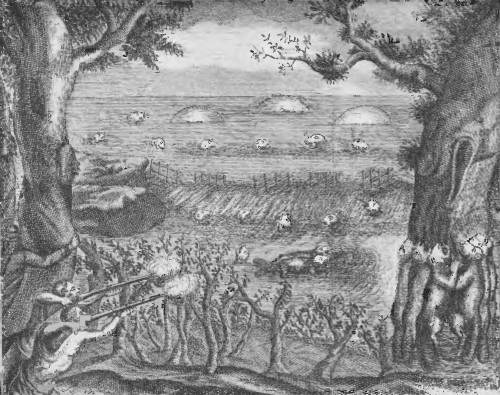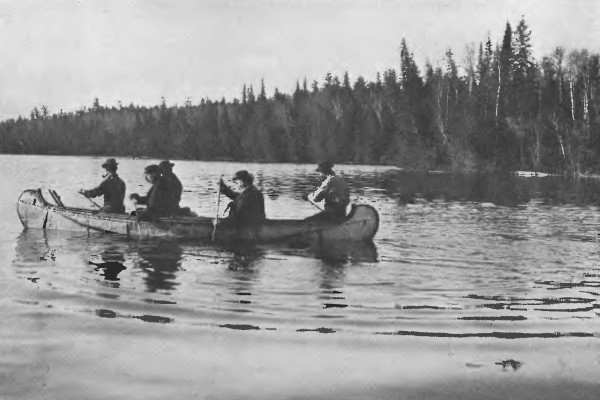Copyright, Kellscraft Studio 1999-2007 (Return to Web Text-ures) |
|
CHAPTER V THE
BEAVER AS A SPECIES OF the order rodentia the beaver is the second in point of size, the only species exceeding it being the Capibara (Hydrochoerus capivars) of South America. The American and European beaver constitute the only living representatives of the genus castor, and the difference between the two is so very slight as to be scarcely noticeable to anyone but a scientist. Externally, except in point of size, the two species are practically identical, the American being slightly larger, but an examination of the skulls shows certain minor differences, chief of which is the slightly greater proportional length of the nasal bones and narrower skull of the European species (Castor fiber). Another less noticeable mark of distinction is that the castoreum obtained from the European species, especially those from Russia, is more valuable and contains a greater proportion of castorin resin and albumen. In point of age the beaver is evidently an animal of great antiquity, not only in its present form but the larger and extinct Trogontherium (of Europe) and the Castoroides (of America), neither of which are believed to be the ancestors of the present-day species, as their fossilised remains have been found in the Pliocene deposits in which were preserved the skeletons of the Mastodon and Mammoth, so that these animals lived during the tertiary period and from the evidence which nature thus preserved there is no reason to believe that the beaver, as we know them to-day, differs in any marked way from those of prehistoric ages. The earliest European Beaver was probably the chalicomys which has been found in the Miocene beds of the Continent. It was considerably smaller than the existing form and “differed from all living rodents in having a perforation of the lower end of the upper arm-bone or humerus” (Lydekker). The largest of the family was the Castoroides, whose skull was only about four inches less in length than that of a lion and was probably the largest of any of the rodents. The beaver, both American and European, had the largest range of any animal, those in Europe having existed all over Europe, including Great Britain (not Ireland) and Asia as far as the Euphrates. During the Pleistocene period they lived in Italy as far as Rome, while the American species ranged all over North America from the Arctic Sea to Mexico. At the present time the American beaver, Castor Canadensis, is chiefly restricted to the more northern portion of the Continent of North America; none are found in the region of the great plains, nor in the more southerly and easterly parts. Practically speaking, their principal habitat is Canada, Colorado, South Dakota, New Mexico and Alaska.
The animal is in general appearance much like a gigantic muskrat with a broad, flat, thick tail. The weight of an adult ranges from thirty-five to sixty or seventy pounds, length up to about forty-five inches, including tail, the scaly part of which is from seven to nine-and-a-half inches long and approximately half that width. The circumference of the body at its largest part is rather over two feet, and the heaviness of the build is shown by the measurement around the neck back of the ears, which is about fourteen inches. The front legs are very short with small feet having five toes. The hind legs are also short but much more heavily built and have the feet webbed from the base of each of the five toe-nails. All toes are furnished with strong nails, those of the front foot being slightly narrower and longer. On the second toe of the hind foot the nail is curiously cleft, presumably for the purpose of combing the hair. The palms of both feet are bare and nearly black in colour. A soft, rather thick hair covers the front hand, while the hind foot, which spreads to a width of about nine inches, is not so thickly covered. The beaver’s tail, about which so much is written, is covered with thick fur and hair near the body, from which it suddenly appears like a broad paddle completely covered with a hard, scaly skin, very dark in colour and with a few short hairs projecting from between the scaly ridges on the upper side. The tail is actuated by powerful muscles, which enable the animal to strike the water with extraordinary force.
A beaver’s head resembles a cross between a squirrel and a rat, though in some ways it is perhaps more like a guinea-pig. It is well coated with hair and fur except the nostrils. The face has five rows of bristles between the nostrils and mouth, and a few bristles over the eye, which is very small, only half an inch in diameter. The ears are short, dark, and hairy. But the most peculiar feature of the head are the teeth, which are most wonderfully developed to meet the animal’s method of living. Their total number is twenty, ten in each jaw. These consist of eight molars or grinding teeth and two incisors for cutting. These latter are the chisel-like teeth with which the beaver is able to cut down the great forest trees. In their construction they are of especial interest. The outside or front is a thin layer of very hard orange-coloured enamel attached to a thick backing of dentine, which, being soft, wears away by the action of cutting and leaves the shell-like edge of enamel always sharp. The lower teeth are of great length, approximately four inches along the outer curve, of which a minimum of about one quarter extends beyond the jaw-bone. The incisors of the upper jaw are both shorter and more abruptly curved. The distance between these and the molars is about one-and-a-half times the space occupied by the groups of molars. These are curious rootless teeth composed of foliated hard enamel, the inside of the folds being filled with soft dentine, which wears away and leaves the ridges sharp and capable of grinding wood or bark to a fine pulp. All the teeth grow continually to make up for the natural wear. In case a tooth is injured or broken the opposite one grows to abnormal length, frequently to the great discomfiture of the animal. The folds of hard enamel continue with little change of form down to the base of the teeth, but the semi-hard dentine is only formed near the grinding surface. The young beaver is born with well-developed teeth, which differ only in point of size from those of the adult. The brain of the beaver is noticeably smooth and lacking in the corrugations which are supposed to indicate intelligence. It seems peculiar that an animal which has so much (from our standard of comparison) to signify inferiority should, by its works, prove itself to be so highly intelligent. Romanes says: “There is no animal — not even excepting the ants and bees — whose instinct has risen to a higher level of far-reaching adaptation to certain constant conditions of environment, or whose faculties, undoubtedly instinctive, are more puzzlingly wrought up with faculties no less undoubtedly intelligent.”
The beaver’s coat is composed, like that of nearly all fur-bearing animals, of fur and hair. In the beaver it is thick, woolly, brown fur about three-quarters of an inch in length, while the hair is from two to two-and-a-half inches long, dark in colour and fairly shiny. The general colour of the animal is chestnut brown, but it varies considerably according to locality, from a lightish yellow to very dark brown, and in very rare instances to almost black. Albinism, either partial or complete, is comparatively rare. The colour of the young beaver is decidedly greyer than that of the adults, the length of one four days old is about fourteen inches. Outwardly there is nothing to distinguish the sexes, except when the female is suckling her young; then her four teats, which are situated between the fore legs, are slightly enlarged. The number of young at birth varies from two to six, rarely more, the common number being four. They are born between the end of April and beginning of June after a period of gestation which is believed to last about fourteen weeks. In swimming the beaver uses its hind legs and to a very limited extent its tail, chiefly for sudden starts and turns. In this respect it differs entirely from the muskrat, which swims chiefly with its tail, which acts as a scull. The front feet are, as the trappers say, “put into its waistcoat pockets,” in other words, held downwards along the sides. The head is clearly visible when the animal swims and the top of the back more or less so according to the speed at which it is going. When lying perfectly still at the surface of the water the tail also may be seen. Under water the head is held lower or more directly in line with the body as far as I have been able to judge, and they can remain under water for six or seven minutes or even more, according to some observers. When submerged the ears are closed, as also are the nostrils, except when slightly opened to emit the vitiated air. In slapping the water with the tail it has been fairly well proved by means of my photographs that the position assumed by the animal is not at all according to previously published accounts in which the impression has been given that the head is down or even under water at the moment of the slap, whereas the head and the shoulders are actually held very high out of the water as the tail is raised. The action is so rapid that it is practically indistinguishable to the eye. In diving the beaver can go down so quietly that there is no disturbance to the water’s surface. On land the beaver walks with its back much arched and tail dragging; when listening it usually stands erect on its hind feet with the tail used as a balance, and when sitting down it often brings the tail round forward and even sits on it, though personally I have never seen this position. The eyesight of the beaver is fairly keen, but they depend more on their extremely acute senses of hearing and smell, particularly the latter, which is very highly developed. Like most wild animals they realise the importance of wind and always select the lee side of a pond when on watch. Castoreum, for which the beaver is famous and has been for at least twenty-four hundred years, is a peculiar substance secreted in two glands situated below the pubis. It has a mild and not unpleasant odour which is supposed to be very attractive to many kinds of animals and consequently is used by nearly all trappers in preparing “medicine” with which to lure the various fur-bearers to the traps. It is also believed to possess extraordinary medicinal properties, and has been in use for over two thousand years. Martin states that “the earliest references we have to the beaver in history date back to 500 B.C., when Hippocrates mentioned it in connection with medicinal uses of castoreum, and from the fact that Pliny wrote that the creature’s life was spared on surrender of the valuable pouches of castoreum, we gather that it was for these alone that the animal was hunted.” The substance in various forms was used as a cure for headaches, deafness, abscesses, gout, epilepsy, colic, toothache, sciatica, lethargy, fever, pleurisy, “induces sleep and prevents sleepiness,” helps memory and cures tuberculosis and rheumatism, and is of benefit to mad people. It was also used in smoking with soothing effect by the Indians. Surely an array of virtues not surpassed by even the most imaginative quack doctors in advertising their “cure-alls!” We may laugh at the ancients for their faith in castoreum, but they were not altogether alone in their belief, for it is to-day highly prized if we may judge from the fact that it is sold for about ten dollars per pound. It takes the “castors” of four or five or even six beavers to yield a pound of the substance and the demand always, I am told, exceeds the supply. From this we must believe that we do riot differ very much from the ancients. Besides the castoreum the beaver fat also was considered valuable for medicinal purposes by the Indians who used it, among other things, for preventing and curing frost-bite and for rubbing limbs afflicted with rheumatism just as some of the African tribes use the lion’s fat. Beaver teeth were employed to some extent by Indians as chisels before they learned the value of metal. But perhaps the greatest commercial value of the beaver was the fur which was used for making hats. During the seventeenth and eighteenth centuries the beaver hat was of even greater importance than the silk hat is to-day, and very much more expensive, for the price of a good “beaver” ranged as high as eighty or ninety shillings, and, strange to say, old skins that had been in use were more sought after than new ones. Later on other furs were used for making hatter’s felt; this reduced the demand for the beaver skins, while the discovery of silk plush, as a substitute material for hats, practically ended the use of beaver fur so far as the hatter was concerned. Now its furs are only used for the adornment of people, as linings of coats, collars, and muffs, and other similar purposes. They are made up either with the hair on or plucked so that the thick fur alone remains. The Canadian beaver is divided into five more or less distinct races, which are given by E. T. Seton as: Castor canadensis, Kuhl, the typical form and smallest (a). Castor carolinensis, Rhoads, larger than the type with broader tail (b). Castor frondator, Mearns, larger and paler than the type, with scaly part of tail shorter than twice the width (c). Castor pacificus, Rhoads, largest and darkest of all, with scaly part of tail longer than twice the width (d). Castor texensis, Bailey, very large and pale, with scaly part of tail longer than twice the width. The distribution of the type, Castor canadensis, is approximately the whole of Canada, and northern United States to within three or four hundred miles of the Pacific Coast, and down to about latitude 38 degrees, except in the part west of longitude 103 degrees, where frondator is found. In the central southern portion of the United States they are classed as texensis, while those in the south-eastern states are carolinensis and all that are found on the Pacific coast are called Castor pacificus. The European beaver, Castor fiber, still exists in a few places in Europe, chiefly, I believe, in Norway, where, in 1883, there were said to be about one hundred near Arendal; these have been strictly protected and have therefore increased. Formerly they existed in great numbers throughout most parts of Europe, also in Asia, northern and central. In Livonia as recently as 1724 they were so abundant that they were considered a nuisance and the last is said to have been killed in 1841. In Holland they were exterminated in 1825, while in western Germany the Moselle and the Maas were noted for the number of beaver. In 1829 there was a flourishing colony on the Elbe near Magdeburg. In
England and Wales the beaver was found up to about the twelfth
century; the Welsh name was Llost-Llydden, signifying broad-tail. The
last record of them in that country was, according to Giraldus
Cambrensis, in 1188, when they were found in the Teivy,
Cardiganshire. King Howel Dda, who died in 948, fixed the price of
beaver skins at 120 pence, which shows how greatly they were
appreciated, as fox, wolf and stag were valued at only eight pence.
The beaver’s name in England has been perpetuated by very few
places such as Beaverage, Beverley, Beversbrook and Beaver-bourne, in
marked contrast to the United States and Canada where the name will
be preserved by literally thousands of towns, villages, rivers,
streams, lakes and ponds. In Scotland the beaver continued later than
in England, but curiously enough there is nothing to show that it has
ever existed in Ireland. HINTS ON BEAVER PHOTOGRAPHY. FEW animals large or small are less suited to photography than the beaver. To begin, they are rather shapeless, with inconspicuous legs, no pattern in the way of colouring, and what makes the work doubly difficult and unsatisfactory is that they are so seldom to be seen by daylight. Add to this the fact that they are usually wet and very shy, and it will be easily understood that the task of securing really good photographs is not easy. I may even say that in all my experience of hunting with the camera no animals have ever given me so much trouble. The best pictures I have ever obtained of lions and other big and dangerous beasts were secured with far less difficulty than even the worst of my beaver studies. This is said so that those who may attempt the work will not be disappointed if success is slow in coming. The surest way is of course by flashlight and the surest place is at the dam. A small break in the structure will be almost certain to induce the beaver to come to repair it, as they don’t like to let the water escape. The camera may be placed on or near the dam so that the opening is about in the centre of the plate. A black thread across the breach, about five inches above water-level (to avoid muskrats), attached to the flashlight and shutter should answer the purpose if you have a satisfactory outfit, but bear in mind that every part of the apparatus must be protected from damp, and sufficiently firmly placed to prevent being blown over by sudden winds. It is not necessary as a rule to conceal the camera, as the beaver pays but little attention to it; he is more interested in the scent left by man, so it is as well to throw water over footprints and anything near the ground that has been handled. If all goes well you will get lots of exposures, hut in most cases the pictures will show simply a shapeless mass of wet fur to take the place of the beaver. Such at least has been my experience, for out of about thirty exposures only four or five showed the animal with any shape. Don’t forget that the beaver moves quickly, so the exposure should be very short. On land the difficulties increase enormously, There are so many trees to which the animal may come that it is no easy task to select the one to which he will come. The surest way is to lay a seductive branch of birch or maple on a regular pathway, and arrange the camera accordingly. When work is being done on the lodges there is always a chance of securing photographs of the animal carrying up mud or sticks, but great precaution must be taken not to disturb the surroundings, or cause suspicions, and everything should be done as quietly as possible. Be sure not to let moisture condense on the lens of your camera. This causes more failures than anyone will believe. During the autumn in northern countries everything becomes covered with a fine mist-like condensation. This is particularly noticeable on glass, and you cannot get a sharp image through it. Therefore wipe the lens thoroughly or protect it carefully by means of a hood which will open immediately before the exposure. I dare not give information as to the best kind of outfit to use, for I have not yet found such a thing. Some new devices are being offered now, but not having tried them I do not feel justified in either giving their names or in recommending them. So far I have had the best results with electric apparatus, as they are quick, almost silent and fairly convenient, but they don’t always work. If using any sort of electric device, be sure to have an ample supply of batteries to take the place of those that through mishap become exhausted. I have had a tree dropped on my outfit, branches pulled between the legs of the tripod, which was of course upset, and many other accidents, which go to show that the pitfalls of beaver photography are many and trying. A good temper, plenty of patience, a reasonably good outfit and a proper share of luck are the ingredients necessary. All successful photographs will be well earned, and consequently they will be greatly appreciated, at least by him who has the good fortune to make them. To avoid too much disappointment it is just as well to develop all flashlight exposures before resetting the cameras, as the number of ways in which failure may come is limitless. |
Web and Book design,
Copyright, Kellscraft Studio
1999-2007
(Return to Web Text-ures)

